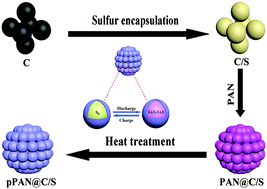Elemental sulfur has attracted great interest for rechargeable batteries because of its high theoretical specific capacity and low cost. However, sulfur electrodes still suffer from rapid capacity fading, which is mainly caused by the undesirable dissolution of polysulfide intermediates and the irreversible deposition of discharge products. In this work, we describe an interconnected core–shell pyrolyzed polyacrylonitrile@carbon/sulfur (pPAN@C/S) nanostructure for high-performance lithium–sulfur batteries. Sulfur was firstly confined in a conductive porous carbon host as C/S to enhance the conductivity of sulfur, constrain polysulfide intermediates and alleviate volume expansion during cycling. Then a conductive pPAN shell was formed by annealing of PAN absorbed on the surface of C/S at 300 °C to further prevent polysulfide intermediates from dissolution by an additional physical and chemical barrier. Meanwhile, the conductive pPAN shell could prevent the irreversible deposition of insoluble discharge products, leading to improved cyclic stability. The interconnected core–shell pPAN@C/S electrodes exhibit a very high initial discharge capacity of 1269 mAh g−1 at 0.5 C and show excellent cycling stability and rate performance.

